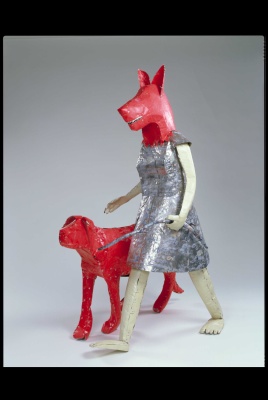HAROLD STEVENSON INTERVIEW
by Tawsha Brinkley Davenport

Edie Sedgwick and Harold Stevenson in a clip from film footage
shot by Factoryite Danny Williams during the 1960s
In a modest log cabin in Idabel, complete with a Whippet dog stretched out by the fireplace and surrounded by black and white family photographs from a life-time, lives one of America’s most important figures of the modern pop art world – Harold Stevenson Jr.
He has been described as one of the art world’s living icons with work that spans almost seven decades. And his work, alongside Andy Warhol and other artists of the time, is part of a generation that was once classified by a 1962 art show in New York City as the "New Realists."
Even with all of his fame and successes across Europe and in the United States, Stevenson remains a longtime resident of Idabel. And as he says, he never really left.
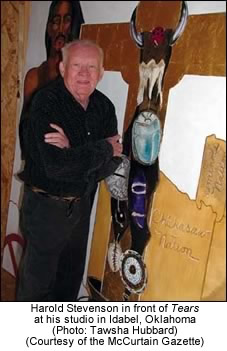 “Someone came up to me at the post office recently and this lady said to me, ‘Out of curiosity, Mr. Stevenson, just when did you leave Idabel?’ I said, ‘Darling, you must be new in town because I never left Idabel.’”
“Someone came up to me at the post office recently and this lady said to me, ‘Out of curiosity, Mr. Stevenson, just when did you leave Idabel?’ I said, ‘Darling, you must be new in town because I never left Idabel.’”
“I kept coming back through all of the years, whether I was staying in France, England, Italy, wherever; and in other words, I have always had the same legal address at my family’s home, literally,” said Stevenson.
His family can be described as one of the first pioneer families to arrive in the community “besides the Native Americans.” His grand-father came to the town in 1902, years before Oklahoma was a state,
“He was a doctor. Doctor Dove Stevenson. I love that name. I think it was just barely called Idabel then. So I think I am just about as native as I can get.”
Stevenson said his family home, which he still owns, was one of the first brick residences in the town.
“There is a funny story about that house. The Wootens were bricklayers and they wanted to start building brick residences for people, so they chose my grandfather. They said, ‘Now, Dr. Stevenson, you know the hand-cut bricks are still a little bit cheaper than those machine-cut bricks.’ And my grandfather said, ‘Those hand-cut bricks will do just fine.’ I believe now it is the only home with hand-cut bricks that still exists today,” said Stevenson.
For his parents’ wedding gift, his grandfather gave them the gravel pit outside of Idabel. “Most of the streets of Idabel were made from my gravel pit,” said Stevenson.
He was born March 11, 1929, to Harold Stevenson Sr. and Mary Jim Stroud Stevenson.
“Her middle name was Jim because her grandmother’s brother was a doctor during the Civil War. He was present to oversee the birth of my mother,” said Stevenson. “I love history,” he added.
At the age of 10, Stevenson became a serious painter, and he was largely self-taught.
“Up until that time, I wasn’t too serious. I mean, I invented painting for myself. And prior to that I had elocution lessons at age three with the girl who lived across the street from me, Helen Ardent. We were performing at age four. I guess the path of my life was already destined for the arts one way or the other,” said Stevenson.
When he entered the second grade, it was then he first decided to become a painter.
“Mrs. Edna Brown, my second grade teacher, always told a story. She said, ‘Well, I decided to let Harold to go on drawing because I couldn’t distract him from that.’ She was a wonderful person and she came to visit me when I was living in France,” said Stevenson. “So I began at the house in town.”
Stevenson said he learned all about the art world right in Idabel.
“Well, one of the things that was a great challenge to me was before I went to New York; I already knew what was going on in the art world. I learned through magazines and books. The library in Idabel was very small. But it was amazing how much information could be had by the library.”
Stevenson recalls the history of the library in Idabel.
“During World War I the city built a little house that was lodged in the middle of Central and Main Streets at the crossroads. It had just one door. And when the war was over, they moved this little house as it were onto the courthouse lawn and it became the first library.
“And as I lived close by, I found my way to the library very quickly. So you know, by WWII it was still there. There was no other library.”
At the age of 10, Stevenson found a way to reach others with his artwork. He opened a studio downtown.
“I sold paintings out of there. I painted all of the people who came there and that was everybody. People came there like they went to the drugstore, city hall or something,” said Stevenson.
“It was the only art studio, so everyone just came to it like it was a public building – which pleased me. And as they came I painted them. It didn’t take me very long to do a portrait. I am a figurative painter. I paint the human figure and I have always been since that first studio,” said Stevenson.
When it was time for college, he attended the University of Oklahoma in the 1940s, but it was in 1949 that he arrived in New York. It wasn’t long before he found himself as part of the New York art scene.
NEW YORK
"Andy Warhol and I both met when we came to New York in the same year of 1949. I knew Andy very well,” said Stevenson. "He was one of the first people I met. Nobody knew him then.”
Stevenson enjoyed success in 1949 with three one-man shows in San Francisco, Dallas, University of Oklahoma, and the Oklahoma Art Center. It was during this time he helped Warhol get his first exhibition at the Bodley Gallery in New York. On a trip to France, he decided to stay and in 1959 Stevenson became a resident for 20 years.
“I have lived in France and Italy. But I fell in love with Paris many years ago in the Fifties,” said Stevenson.
“This is fair to say: You know, I never did become a New Yorker in spite of all of the times I have lived there and what-not – unlike so many people who go to New York and in two days are really New Yorkers."
“But I did fall in love with Paris. I became a part of that life. In the late 1950s, all through the Sixties and Seventies, I had my own studio and apartment.
“I think the thing I was most proud of in Paris is I had my own telephone in my own name. I always felt that was the most significant thing. It meant you were really there,” said Stevenson.
“I spent a lot of time in Italy; I loved Venice. I produced a lot of sculpture in Venice, in glass,” said Stevenson.
There he saw success with his one-man show at the Galerie Le Cour d’Ingres in Paris in 1960. It was in 1962 his one-man show "Le Sensuel Fantastique" at the Galerie Iris Clert included the portrait of Lord Willoughby d’Eresby in 25 pieces. Willoughby was the grandson of Lady Astor, who was Nancy Astor, the first woman to serve as a member of the British House of Commons.
“Timothy and I were great friends until he died in 1963. It is curious because he invited me to go on this boat. I had always been afraid of water. I said, ‘Oh, Timothy.’”
Stevenson remained on land. “He wanted to go to Corsica in this boat. He was lost at sea with his crew. But that’s why I’m still alive today,” said Stevenson.
THE NEW REALISTS
"The New Realists" exhibition of pop artists debuted in 1962 at the Sidney Janis Gallery in New York. One of Stevenson’s most famous paintings, Eye of Lightning Billy, was included in this exhibition.
“Roy Dale Billy, a McCurtain County resident, better known as ‘Lightning Billy,’ was the model for it. In fact he was a model for several of my paintings. But that painting was very famous,” said Stevenson.
Stevenson’s work has been described as a “lifelong experimentation with the sensual possibilities of figuration.” And as in many of his paintings, he explores the extreme close-up of body parts, like the Billy painting that is a close-up of Billy’s eye presented in six pieces. Together the piece measures 10 feet by 15 feet.
“The show toured all over the world. There were about a dozen of us in the show,” said Stevenson.
Around this time Stevenson appeared in Warhol’s first film.
“I became the subject of his first movie which is a black and white silent film called Harold,” said Stevenson. Stevenson also appeared in several other Warhol films including Heat where he is credited as Harold Childe.
EDIE SEDGWICK
It was during this time when Stevenson became fast friends with socialite-turned-Warhol-protégé Edie Sedgwick.
“I was a great, great friend of Edie Sedgwick. Someone said they are doing a film about her. I don’t know why no one has contacted me about it. I can’t imagine them doing it without me. I don’t see how it could be possible,” said Stevenson.
The film, Factory Girl, is currently in production in Louisiana starring British actress Sienna Miller.
“Edie and I were in several of the early Andy Warhol films,” said Stevenson.
“Edie was beautiful beyond words. She was absolutely breath-taking and a very sweet person. Edie was a precious person. She was heavily into drugs which caused her death. We were very good friends. I took her to an exhibition once of artist Rene Magritte. And we were photographed by everybody and with the artist Salvador Dali. He came up to me and said, ‘I want to be photographed with you and Edie.’ And I said, ‘Well, get in here.”
“Dali is one of the great legends of art. He was an eccentric, but then I am an eccentric, an Idabel eccentric. My grandfather and father were eccentrics. I always thought it was one of the most natural things in the world to be an eccentric,” said Stevenson. "But Edie was very glamorous. And truly beautiful, breathtaking, and I think it was a great loss she died so young.”
Sedgwick died in 1971.
GLORIA SWANSON
During his time in New York Stevenson met silent film star Gloria Swanson, whose career was revived with the 1950 movie Sunset Boulevard.
“I met Gloria Swanson in the 1960s. Well, she was a very good dancer. When I was introduced to her, for once I said the right thing. I said ‘Miss Swanson, would you like to dance?’ And she said, ‘I’d be delighted.’ So we danced.
“We were at a private party where there was an orchestra and it was a very fancy party. Gradually everyone left the floor and Gloria Swanson and I were left alone on the floor. The orchestra went into a tango, so I couldn’t abandon the moment. When I took her back to her table she said, ‘Well, he was just as good as Rudolph Valentino.’ It became a big story,” Stevenson recalled.
“As a matter of fact, after that we had lunches and dinners together many times. Once I was telling her about being in Andy Warhol’s films and she said, ‘I never heard of him. Does he work for Metro Goldwyn-Mayer?’ I answered, ‘Hardly.’”
“You know, there is that moment where people don’t realize what’s going on in the world, especially in the art world, and it takes some time to spread out.”
THE NEW ADAM
One of Stevenson’s best known works is The New Adam which The Guggenheim Museum in New York acquired last year.
“They are preparing for a show, but I’m not sure about the date yet,” said Stevenson.
Sal Mineo, who is best known for his role of Plato from the James Dean movie Rebel Without A Cause, posed for the painting in Paris. According to an interview from In Touch magazine in the 1960s, Mineo said he noticed a small painting of Stevenson’s in Paris and he inquired about the painter. Mineo contacted Stevenson. He said it was later after they became friends that Stevenson asked him to pose for him.
The portrait of a nude Mineo is 7 1/2 feet by 39 feet on nine panels in linen. When the painting was exhibited in 1963 at The Richard Feigen Gallery at Los Angeles, the movie Harold was shown as well.
“It was the first time a movie was shown as a work of art. That was very adventurous for 1963. There was a direct flight from Paris over the North Pole to Los Angeles that I took for the show. Sal Mineo met my plane in Los Angeles. He also came to Idabel. He was very gentle, a rather shy person. And he was small. He had a tragic end; he was murdered by a stranger,” said Stevenson.
Also in 1963 in Paris his four-stories-tall painting El Cordobes was exhibited on the Eiffel Tower.
“The face and hand of the matador El Cordobes is the subject of the painting,” said Stevenson.
In 1964 Stevenson had three one-man exhibitions at the Richard Feigen Galleries in New York. During his years in France he traveled to Italy, England, New York and back to his home in Idabel, often bringing known celebrities to Idabel.
He would have incredibly famous people from all over the world come visit him at his Idabel studio – people like Lord Snowden of the British Royal Family, a long-time friend, famous movie stars from Hollywood, celebrated authors and writers from the highest levels of literature, and renowned stage performers from Europe,” said Ron Clark, former Idabel resident and fellow artist.
“In my life I spent time in Italy and London, Spain, and Idabel, not only France,” said Stevenson.
“I always came back to Idabel. I was one of the first jet-setters. I always moved around. I didn’t think anything about it. If I felt I needed to be in Italy, I went to Italy,” said Stevenson.
Other influences Stevenson said he really wasn’t influenced by other artists.
“Well, it is hard to say because you must remember that I invented this thing of painting when I was a child. So there wasn’t much chance for influence, because I started so young. I have my favorites like Leonard Da Vinci, which goes back pretty far,” said Stevenson. “I have always loved other artists and all, but that doesn’t necessarily mean that I wanted to paint like them.
JACKSON POLLOCK
“For example, I knew Jackson Pollock very, very well. But I didn’t want to paint like him. We were very good friends. What is interesting about Jackson Pollock’s life is that he is, I suppose, the most famous Jewish painter who wasn’t Jewish. What happened is a curious story. Right after WWII, the eyes of the world were focused on America. So America needed a new face on the art scene. And it just so happened that fell into place with Jackson Pollock. So he became a household word overnight, so to speak, you know, through Life magazine and all. All of us wanted to be famous like Jackson Pollock; you know that was natural. But then many people tried to paint like him and I always thought that was a mistake,” said Stevenson.
“There is no answer to what a painter likes of his work over another. It’s not a matter of enjoying one thing over another; it’s a matter of the moment. Whatever the moment calls for. Doing what is the moment. That is how I paint – whatever I am involved with at the time.” Stevenson likes to paint just ordinary people.
“The celebrities were my least favorite models. I always have favorite models in various periods of my life. There was Lightning Billy, all through the 1950s, then Lord Willoughby. And currently at my studio in the Hamptons in Long Island is Christopher John. He is the subject of many of my current paintings.
“I did an enormous landscape of Idabel years ago. It is a view looking south from one of my previous studios here. That painting is owned by Ross Dugan Jr. in California. So if anyone says where can I see a painting of yours that’s not a person, I tell them you have to go to California.”
Stevenson is an artist who doesn’t collect art or keep many of his own.
“Someone said to me, ‘Don’t you hate to give up your paintings?’ I have a lot of them. I wish I could get rid of them. What I am trying to say is, it is a way you also make your living. I never had any job. Never. I have always painted and lived selling my paintings even as a child. I have been self-employed an entire lifetime,” said Stevenson.
Since the library is one of the resources Stevenson used to get his start as an artist, he hopes Idabel will be able to build a new one soon.
“It is one of my greatest hopes. One of the reasons why is I have a big collection of books and I want to give them to the Idabel library. I also want a library to exist. We really should have a proper library, after all of these years. It is about time. It takes a lifetime to collect as much junk as I have,” said Stevenson. “Some of my books are by authors I have known personally. I knew Tennessee Williams and Truman Capote very well and many others."
Stevenson said he has seen the new film Capote, which is based during Capote’s research of his book In Cold Blood.
“It’s quite good. And I thought Phillip Seymour Hoffman portrayed Truman quite accurately. He didn’t look like him, but it didn’t make any difference because he was a good enough actor you were convinced,” said Stevenson.
1970 - 1990
In 1970 his show, "Sculptures in Crystal," was exhibited in Murano, Italy, at the Knoedler and Company. Each year after that, Stevenson’s paintings were exhibited in various galleries throughout Europe and New York.
“It was during the ‘80s when I established a studio in Key West, Florida, where I stayed for over 10 years,” he said.
Stevenson designed the Tennessee Williams gold medallion for the National Committee for the Literary Arts in 1981.
“Beginning in the 1980s I had a new gallery representing me in SoHo, New York, which is now in Chelsea; it is the Mitchell Algus Gallery. Today they continue to represent me,” he said.
Throughout these three decades Stevenson continued to have exhibitions.
IDABEL TALENT
Stevenson said there have always been a lot of very talented people from McCurtain County.
“I have several protégés from Idabel. Idabel has plenty of artists now, but when I was a child there weren’t any. Poteet Victory, better known to Idabel residents as Robert Poteet, is definitely a protégé and friend of mine. And also Ron Clark, his grandfather, was the barber here for many years, Mr. Waters, and his father was Carl Clark. And it’s amazing to me how some of the families here have been friends for generations."
Stevenson also mentioned Charles Grinch, another McCurtain County resident, and Thela Leonard as being influenced by him.
“Everyone in Idabel who paints has touched my life in some way,” said Stevenson.
The loss of Willoughby and the loss of his brother, Don, who died in his early forties, and his wife touched him deeply.
“With my brother’s death I inherited their four children. You never know what life is going to give you and it gave me four children. My elderly parents were more of a problem than the four children,” he said with a laugh.
“I must say that those four people are all grown on their own and have their own families and what-not. They have been a great, great pleasure to my life. They tend to look after me. They don’t stop to think I have roamed all over the world,” said Stevenson. "What is curious when my nephew Kurt moved to the house in town, he remembered me saying that I always wanted to live in a log cabin. Well, he built this log cabin for me. I am having a big room built on for a studio. I had to have a place to put my things from New York.”
THE GREAT SOCIETY - 100 FACES
Stevenson remains busy. He just returned from Norman where he is preparing for a new exhibit at the Fred Jones Jr. Art Museum at The University of Oklahoma. The exhibit is called "The Great Society: 100 Faces."
“It is 100 faces which I have painted from McCurtain County. The first person I painted for this series is Laverne Deramus Cuzick, a resident of Broken Bow. I painted her in 1965,” said Stevenson.
Even though it is 100 portraits, Stevenson considers it one piece.
“It is the length of a football grid,” said Stevenson. “I want to invite all of the 100 faces to the showing as my guests,” he added.
Stevenson said he would provide further details about the show at a later date.
Another project Stevenson is working on is a joint venture with former Idabel resident Ron Clark.
“We are preparing for a show set to open soon at a new gallery, The Betty Anne Smith Gallery in Dallas,” said Stevenson. "What is curious about this is. Ron, as just a boy, watched me paint the Eye of Lightning Billy here in Idabel.”
STEVENSON'S AUTOBIOGRAPHY
Also in production is Stevenson’s autobiography. The current title of the manuscript is called The Bridegroom Cometh.
“That title is from Matthew the 25th chapter. It is about the wise and foolish virgins. I was always fascinated by that parable. It can be interpreted in many ways. For one thing, you don’t necessarily know when opportunity will come to you.
“I was born and reared a Presbyterian. All of that really has a lot of influence without you being terribly aware of it. As a matter of fact a lot of my paintings are based on religious themes,” said Stevenson.
“I have been writing a long time. I don’t know when I will be published or if I will be published in my lifetime. I don’t really care. I only wanted to leave my version of it. Whatever my life is, whatever is written about me. I’d like necessarily not to have the last word. But I would like to have my word.
“I don’t know if there will be that many that agree with me. We’ll see,” Stevenson added.
TEARS
Stevenson is already making plans for a show early in 2007 at Bartlesville.
“My painting Tears is what I am going to exhibit there. It is a painting that shows the geographical areas of the Five Civilized Tribes and what became of the state of Oklahoma,” said Stevenson.
The show will be at the Price Tower, a Frank Lloyd Wright building.
“It is an exhibition of Oklahoma artists who are known internationally,” he said. Stevenson employs several agents in New York and Europe.
“The only sad thing about being old is most of the people you’ve known are no longer with us. Most of those I used to talk to are in the Denison Cemetery,” said Stevenson. “I am a very good friend in that I stay in touch with all of my friends. There is a constant contact."
Stevenson continues to paint daily.
“I am sure I will be painting until the end,” he said.
When asked about what he thought the reason was why he didn’t receive more recognition in his hometown of Idabel, his reply was; “That is something that usually happens once the artist is out of the way. It is very important. For example, Andy Warhol became very famous as soon as he was dead. As long as he was alive, he was kind of always in the way.”
“Life is very funny,” he added. “I enjoy being at home.”

 “Someone came up to me at the post office recently and this lady said to me, ‘Out of curiosity, Mr. Stevenson, just when did you leave Idabel?’ I said, ‘Darling, you must be new in town because I never left Idabel.’”
“Someone came up to me at the post office recently and this lady said to me, ‘Out of curiosity, Mr. Stevenson, just when did you leave Idabel?’ I said, ‘Darling, you must be new in town because I never left Idabel.’”



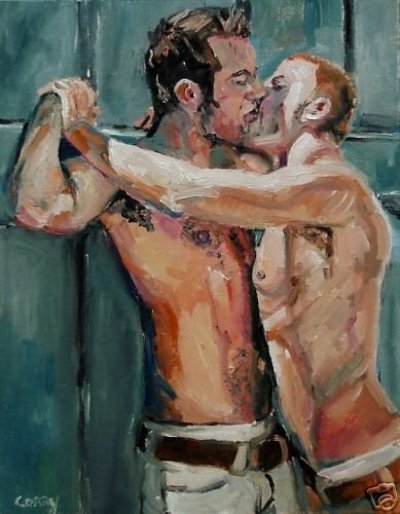
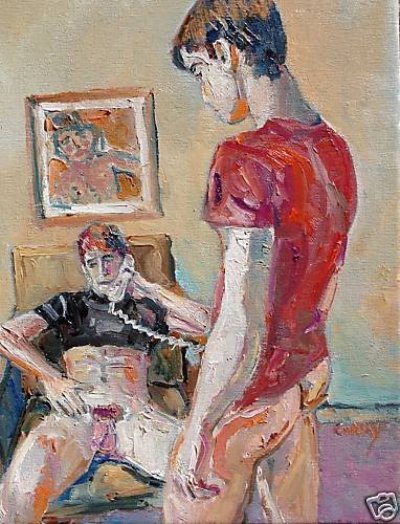
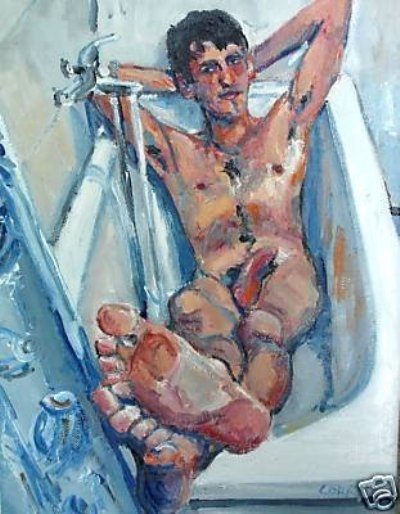
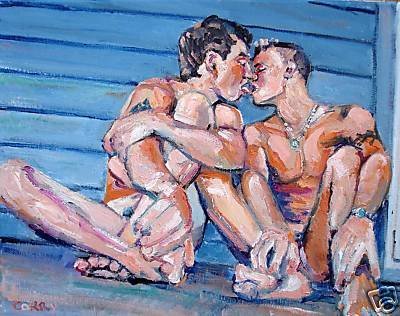
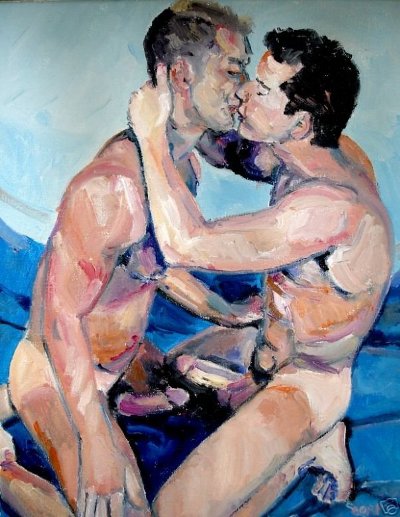
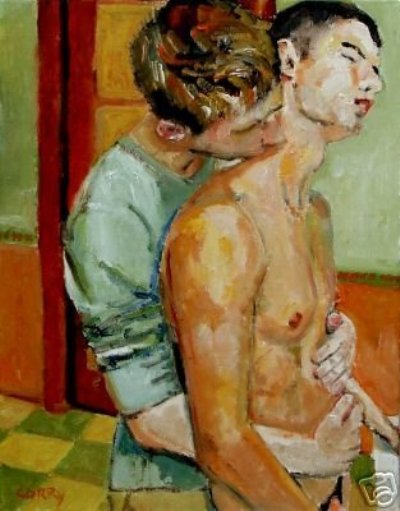
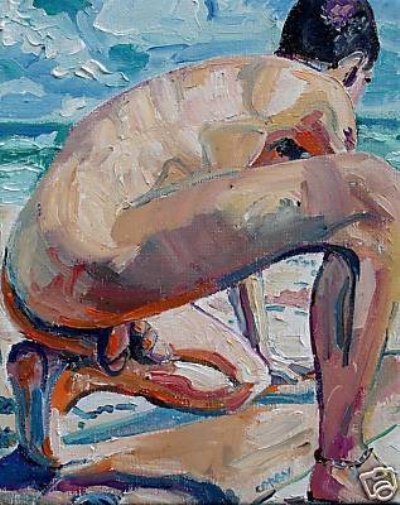
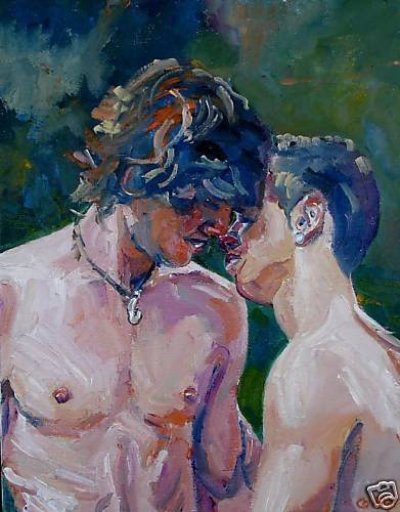
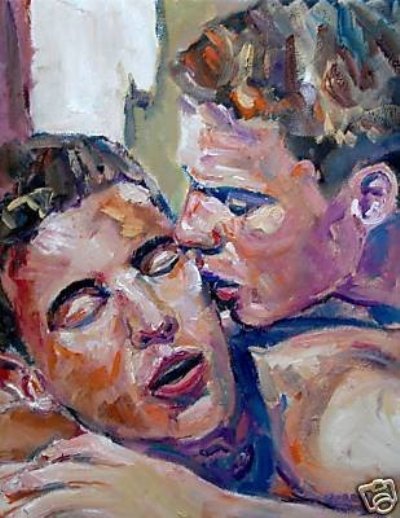






 The BBC1 soap’s production team researched the plot, which is bound to prove controversial with some viewers, contacting academics, gay Muslim support groups and members of the Muslim Council of Great Britain. In the storyline, the 24-year-old Masood, played by Marc Elliott, finds his “religion and sexual feelings in conflict”.
The BBC1 soap’s production team researched the plot, which is bound to prove controversial with some viewers, contacting academics, gay Muslim support groups and members of the Muslim Council of Great Britain. In the storyline, the 24-year-old Masood, played by Marc Elliott, finds his “religion and sexual feelings in conflict”.

 One of the fun things about going out of town and slacking off on the trash research for a bit is that when you finally get around to rooting around for what you missed, there’s quite a bit out there. Treat yourself to this
One of the fun things about going out of town and slacking off on the trash research for a bit is that when you finally get around to rooting around for what you missed, there’s quite a bit out there. Treat yourself to this 



 Image: Plastic Bottles (2007) by photographic artist
Image: Plastic Bottles (2007) by photographic artist 